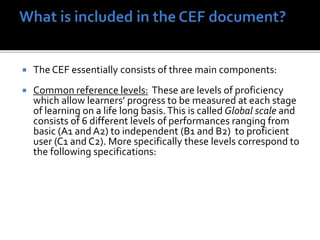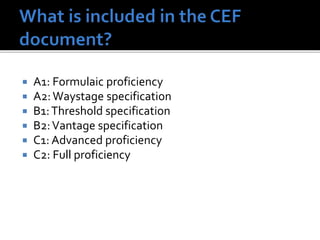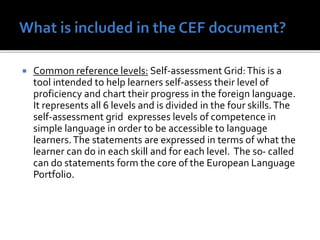ppt CEFR.ppt
- 1. The Common European Framework of Reference for Languages: Uses and users
- 2. ïĄ The CEF is the culmination of work on modern language teaching and learning which in essence began in the 1950Âīs. ïĄ It serves one of the aims of the Council of Europe which is to achieve greater unity among its members by the adoption of common action in the cultural and educational fields. ïĄ The CEF represents a means of developing language teaching in Europe by identifying the objectives and standards of achievement of learners in different national contexts
- 3. ï§ The Council of Europe aim is to achieve greater unity among its members by the adoption of common action in the cultural and educational fields ï§ One way of achieving this aim is to provide a common basis for the planning of language courses, development of curricula, textbooks and exams and through this to achieve mutual recognition of qualifications among European countries and greater European mobility ïĄ Providing a common basis for language curricula and curriculum artifacts the CEF identifies as objectively and comprehensively as possible the criteria for describing language proficiency at various levels.These levels of proficiency allow learner progress to be measured at each stage of learning on a life long basis. The CEF also tries to identify what a fully competent user of a language (not only English) is able to do and what knowledge, skills and attitudes the user needs to develop in order to act effectively in the second or foreign language.
- 4. ïĄ The CEF essentially consists of three main components: ïĄ Common reference levels: These are levels of proficiency which allow learnersâ progress to be measured at each stage of learning on a life long basis.This is called Global scale and consists of 6 different levels of performances ranging from basic (A1 and A2) to independent (B1 and B2) to proficient user (C1 and C2). More specifically these levels correspond to the following specifications:
- 5. ïĄ A1: Formulaic proficiency ïĄ A2:Waystage specification ïĄ B1:Threshold specification ïĄ B2:Vantage specification ïĄ C1: Advanced proficiency ïĄ C2: Full proficiency
- 6. ïĄ Common reference levels: Self-assessment Grid:This is a tool intended to help learners self-assess their level of proficiency and chart their progress in the foreign language. It represents all 6 levels and is divided in the four skills. The self-assessment grid expresses levels of competence in simple language in order to be accessible to language learners.The statements are expressed in terms of what the learner can do in each skill and for each level. The so- called can do statements form the core of the European Language Portfolio.
- 7. ïĄ A descriptive scheme which describes in a comprehensive way a large range of competences which make up the abilities of a user of language at a given level (what the learner needs to learn to do in order to be able to use the language effectively and what knowledge, skills and strategies the learner needs in order to use the language effectively).The scheme also includes factors impinging on language use such as the mental context of the learner and interlocutor and the conditions and constraints under which communication takes place.
- 8. For every one of the elements of language proficiency further sub-division, refinement, subcategories and examples are provided.Thus, for instance, communicative competence includes the following sub-competences. ïĄ Linguistic competence ïĄ Lexical competence ïĄ Grammatical competence ïĄ Semantic competence ïĄ Phonological competence ïĄ Orthographic competence ïĄ Orthoepic competence ïĄ Sociolinguistic competence ïĄ Linguistic markers of social relations ïĄ Politeness conventions ïĄ Expressions of folk wisdom ïĄ Register differences ïĄ Dialect âaccent ïĄ Pragmatic competence ïĄ Discourse competence ïĄ Functional competence
- 9. ïĄ The CEF is a major undertaking as it tries to be as comprehensive and exhaustive as possible. It tries to describe in as much detail as possible the objectives of language learning at successive levels as well as the content of language learning.The authors compare it to a detailed map which does not prescribe your route but gives you details of the topography so you can plan your own route. More specifically, the working group of authors state, the CEF sets out to be: ïĄ Comprehensive: It tries to specify the full range of language knowledge, skills and use so that all users are able to describe their objectives by reference to it. ïĄ Transparent: Information must be clearly formulated, explicit, available and readily comprehensible to users. ïĄ Coherent: Free from internal contradictions. ïĄ Multi-purpose: Usable for the full variety of purposes involved in the planning and provision of facilities for language learning ïĄ Flexible: Adapted for use in different circumstances ïĄ Open: Capable of further extension and refinement ïĄ Non-dogmatic: Not irrevocably and exclusively attached to any one of a number of competing approaches ïĄ
- 10. The CEF is of use to: ïĄ Curriculum/course developers ïĄ By helping them to decide on the objectives for language learning ïĄ By helping decide on the content of language learning programmes ïĄ Test developers and LanguageCertification boards ïĄ By helping decide on their assessment criteria ïĄ By helping them decide on the content of their exams ïĄ Learners (through the self-assessment scale) ïĄ By helping them identify their present state of knowledge ïĄ By helping them set worthwhile and feasible objectives encouraging thus self assessment and learner autonomy. ïĄ Textbook writers and materials developers ïĄ By helping them to decide on the types of texts and tasks that need to be included in materials
- 11. ïĄ It is not a reader friendly document: Its layout is dense, its language is ponderous and very rigid and dry (Eurospeak) ïĄ Specialist terminology is used throughout which is not necessarily compatible with terminology found in the mainstream applied linguistics literature. ïĄ For its comprehension the document requires knowledge of applied linguistics ïĄ It abounds in typologies and lists whose relationship is not always clear. ïĄ The list of self-assessment descriptors refers to a reality closely linked to the world of business, travel, academic work (e.g.booking hotels, writing reports) and not to the reality of the average teenage classroom learner.
- 12. ïĄ In terms of speaking (which is given particular emphasis), the descriptors tend to assume a learner who interacts with a native speaker or a user of a higher level of proficiency (likely in the real world but not in the classroom) ïĄ The CEF does not recommend any specific approach to learning and teaching languages. It is not based or does not promote any specific methodology. It presents options to teachers so that they can make informed choices according to their learner needs and features of their context. ïĄ The CEF specifies in detail what you need to develop in your students in order to make them effective users of the language; it does not, however, specify how you can achieve this. Instead in chapter 6 the authors provide lists of options that teachers may choose from in order to achieve their objectives.












